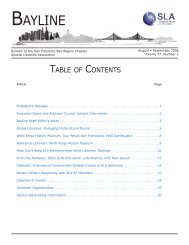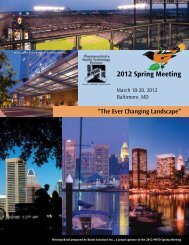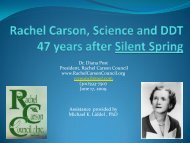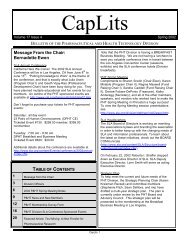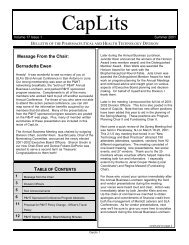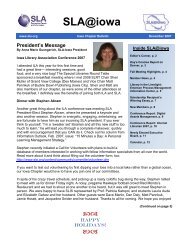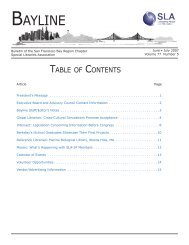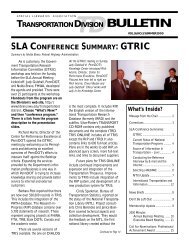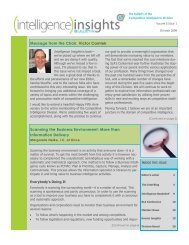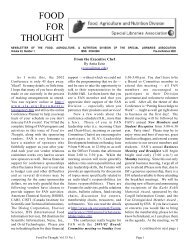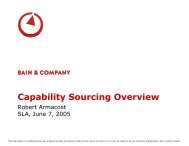Education Libraries - Special Libraries Association
Education Libraries - Special Libraries Association
Education Libraries - Special Libraries Association
You also want an ePaper? Increase the reach of your titles
YUMPU automatically turns print PDFs into web optimized ePapers that Google loves.
Meyer developed a reclassification proposal in<br />
cooperation with the head of Collection Services.<br />
This proposal was supported by the guiding<br />
principles, especially the following principle:<br />
Information and ideas are readily accessible<br />
and freely exchanged. Research ideas, national<br />
standards, state guidelines, the best of<br />
practitioners’ skills, and the changing<br />
educational environment are valued. (See<br />
Appendix B)<br />
At the time, the center’s collections used multiple<br />
classifications, some developed locally. Library<br />
users often had difficulty finding the materials<br />
they needed. Meyer researched the library<br />
literature and found Acquiring and Organizing<br />
Curriculum Materials : A Guide and Directory of<br />
Resources (Lare, 2004) particularly helpful in<br />
developing a standards-based plan to make the<br />
center’s materials more accessible. She also<br />
researched practices among consortial partners in<br />
the region. With input from Carolynne Myall, the<br />
head of Collection Services, Meyer proposed to<br />
adopt a modified Dewey Decimal System for<br />
juvenile materials and to use the Library of<br />
Congress (LC) classification for the remaining<br />
instructional materials and textbooks. The<br />
proposal was approved by the Dean’s Council, the<br />
library’s management team comprised of the dean,<br />
associate dean, division heads, and collection<br />
management librarian.<br />
Though approved by library administrators, it was<br />
cataloging staff who had to implement the<br />
proposal. The staff were asked to develop new<br />
processes to undo the work they had done over<br />
years. The proposal included dividing the center’s<br />
fiction collection into three age-related categories:<br />
EZ for picture books, JUV for children's, and YA<br />
for young adult or adolescent literature, with all<br />
three areas then shelved by the author's last name.<br />
Non-fiction children’s literature was also<br />
converted to Dewey Decimal. Instructional<br />
materials and textbooks were assigned LC<br />
numbers based on subject content (i.e., Q for<br />
sciences) in all formats.<br />
During the reclassification process, everyone<br />
compromised to some extent in adjusting<br />
workflow, priorities, and policies. Cataloging staff<br />
adapted to the changes in processing materials for<br />
the Curriculum Center, and the project was<br />
completed in one year. In addition to thanking<br />
staff during the reclassification project, Meyer<br />
honored them with a celebratory lunch near the<br />
end of the project. Flexibility is a skill that should<br />
be recognized, and expressing gratitude for a job<br />
well done is an important characteristic of<br />
leadership.<br />
Next Steps in the Transformation<br />
The transformation of the Curriculum Center is<br />
not complete; the center will continue to evolve.<br />
In the context of EWU <strong>Libraries</strong>’ strategic plan,<br />
Meyer has identified three priorities in making the<br />
vision of a center for the twenty-first century a<br />
reality: developing and implementing an<br />
assessment plan for the center’s resources and<br />
services, incorporating more educational<br />
technologies, and developing collaboration spaces.<br />
An assessment plan will include systematic<br />
evaluation of the center’s resources and services.<br />
Anecdotally, Meyer has identified several impacts<br />
from the transformation. Students now use the<br />
center as a place to meet and to study, and use of<br />
education databases has increased. Faculty<br />
requests for library instruction have increased, and<br />
faculty members seem more open to share<br />
resources and to collaborate. Library staff take<br />
pride in the new environment. However, the<br />
change is very new, and Meyer does not have<br />
enough qualitative or quantitative data to<br />
demonstrate the full impact of the transformation.<br />
Informal discussion about the role of the<br />
Curriculum Center needs to be more formalized<br />
through focus groups and online surveys. A key<br />
performance indicator will be evidence of<br />
integration of the center’s resources into the<br />
<strong>Education</strong> Department’s curriculum. She is<br />
gathering usage statistics of the center’s materials<br />
and databases for regular analysis.<br />
The incorporation of educational technology is a<br />
major shift that has occurred in K-12 schools, and<br />
students need to be skilled in evaluating and<br />
incorporating technological resources. The<br />
Curriculum Center is one of several places for<br />
students to develop these skills. The learning<br />
<strong>Education</strong> <strong>Libraries</strong>, Volume 31, No. 2, Winter 2008 26



